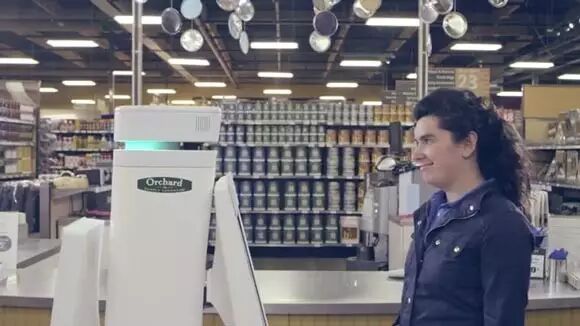
Silicon Valley is entering a new era centered around artificial intelligence and robotics. Judging by the behavior of financiers and entrepreneurs, the current revival of artificial intelligence is likely to continue thriving.
Today’s recommended article, “John Markoff: Silicon Valley Embraces AI, Enters a New Era,” comes from Toutiao Machine Heart.
For over a decade, tech investors and entrepreneurs in Silicon Valley have been obsessed with social media and mobile apps, which helped people find new friends, get rides home, or crowdsource reviews for a product or movie. Now, Silicon Valley has found its next new spark, and it doesn’t require people to “like” anything.
The new era in Silicon Valley is centered around artificial intelligence and robotics, and many believe this shift will ultimately yield scalable benefits in the personal computer industry or commercial internet, just as the previous two eras spread computer technology globally. Computers have begun to speak, listen, and see the world, and they have grown legs, wings, and wheels, allowing them to move freely in the world.
This transformation was validated this month at Lowe’s home improvement stores in the U.S., where a prototype garage checker developed by Bossa Nova Robotics quietly glided through the aisles, using computer vision to automatically complete a task that humans have performed manually for centuries.

This robot skillfully gives way to customers, avoids unexpected obstacles in the aisles, and chirps softly to alert people of its presence. As it glides leisurely down the aisle, it can recognize barcodes on shelves and use lasers to check which items are out of stock.
Financiers and entrepreneurs in Silicon Valley are enthusiastically diving into artificial intelligence. There are now at least 19 companies in the region designing self-driving cars and trucks, compared to only a handful five years ago. Additionally, over six categories of mobile robots are in the process of commercialization, including robotic waiters and drone delivery systems.
“We witnessed a slow accumulation of investment in robotics, followed by a sudden explosion—there seem to be a dozen companies promising large-scale funding rounds, focusing on specific opportunities in the robotics sector,” said Martin Hitch, CEO of Bossa Nova (based in San Francisco, USA).

According to market research firm CB Insights, investment in artificial intelligence startups rose from $145 million in 2011 to $681 million in 2015, more than quadrupling. CB Insights estimates that new investments this year will reach $1.2 billion, a 76% increase from last year.
“Whenever a new perspective emerges, Silicon Valley rushes in and grabs hold of it tightly,” said Jen-Hsun, CEO of chip manufacturer Nvidia. Nvidia produces graphics processors for the video game industry but decisively pivoted to artificial intelligence applications last year. “However, you have to wait for good ideas, and good ideas don’t come along every day.”
In contrast, investment in social media startups peaked in 2011 before plummeting. That year, venture capital firms completed 66 deals related to social media, investing $2.4 billion. According to CB Insights, there have only been ten investments in social media so far this year, totaling $6.9 million. Last month, LinkedIn, the world’s largest professional social network, was acquired by Microsoft for $26.2 billion, highlighting that social media has become a saturated market segment.

Even the largest social media companies in Silicon Valley are now entering the field of artificial intelligence, just like other tech giants. Facebook is using artificial intelligence to improve its products. Google will soon compete with Amazon’s Echo and Apple’s Siri, which are AI devices capable of listening, answering questions, and placing e-commerce orders at home. Microsoft President Satya Nadella recently appeared at the Aspen Ideas Conference, calling for humans to collaborate with AI systems to enhance humanity with designed machines.
The automotive industry is also establishing a presence in Silicon Valley to learn how to manufacture cars that can drive themselves. Tech companies and automakers claim that increasingly powerful sensors and AI software will enable cars to start self-driving with the push of a button within ten years—though recent Tesla accidents have raised questions about how quickly self-driving technology will replace human drivers.
The new era of artificial intelligence in Silicon Valley emphasizes the region’s ability to reshape itself and quickly follow recent technological trends.
“This is at the core of Silicon Valley’s culture, which can be traced back to the Gold Rush era,” said long-time tech observer and Singularity University faculty member Paul Saffo. “Silicon Valley is built on the idea that there is always a way to restart and find new beginnings.”

Technological changes are stimulating a talent influx into the competitive field of artificial intelligence.
“This is absurd,” said Richard Socher, chief scientist at software manufacturer Salesforce, who teaches a course on machine intelligence techniques known as deep learning at Stanford University. “Because today’s students know very little about artificial intelligence, there are many who want students to drop out midway.”
Silicon Valley’s pursuit of reinvention can be traced back to the mid-1970s when it rose from the ashes of a severe decline in the aerospace industry to become a consumer electronics manufacturing center for memory chips, video games, and digital watches. The early 1990s slump in the personal computer market was replaced by the subsequent World Wide Web and the global expansion of internet consumers.
Ten years later, in 2007, just as mobile phone innovation was about to shift from Silicon Valley to Europe and Asia, Apple launched the first-generation iPhone, reshaping the mobile communications market and ensuring that Silicon Valley—at least for the next generation—remains the world’s center of innovation.

In this latest transformation, some new perspectives on artificial intelligence first emerged from the work of cognitive scientists and computer scientists in Canada (such as Geoffrey Hinton, Yoshua Bengio, and Yann LeCun) over the past decade. The three are pioneers of deep learning, a new technology that effectively addresses the challenges of pattern recognition, such as vision and speech. Based on a comprehensive understanding of how the human brain works, deep learning helps technicians make rapid progress across a wide range of artificial intelligence fields.
People are fervently discussing how far the prosperity of artificial intelligence will go. For some technicians, today’s technological advancements lay the foundation for truly intelligent machines that will soon possess human-level intelligence.
However, Silicon Valley has faced setbacks before investing in artificial intelligence. In the 1980s, early entrepreneurs believed that artificial intelligence was the wave of the future that would spawn a wave of startups. The products of those startups had little commercial value, leading to disillusionment and disappointment, resulting in what is now referred to as the “AI winter.”

The current revival of artificial intelligence will not be a fleeting moment, several investors say they believe its economic potential in terms of new efficiencies and applications is enormous.
“There will not be another AI winter,” said Shivon Zilis, an investor at Bloomberg Beta focused on machine intelligence startups.
John Shoch, a senior venture capitalist at Alloy Ventures in Palo Alto, California, said that deep learning significantly impacts the success potential of artificial intelligence companies. He stated, “You have a new set of tools that allow you to delve into a range of new problems, which will expand the boundaries of applications.”
For others, like Jerry Kaplan, who helped found two artificial intelligence companies in the 1980s—Symantec, which became a securities company, and Teknowledge, which ultimately failed—the new enthusiasm in Silicon Valley is unsettling, as it reflects a blind optimism reminiscent of earlier times when artificial intelligence was overhyped and ultimately did not develop.
“In the face of Silicon Valley’s enthusiasm for artificial intelligence, I sometimes hesitate, feeling like an atheist at a revival meeting,” he said.


Long press the QR code to connect with Toutiao
What you care about is what Toutiao cares about丨Today’s Toutiao